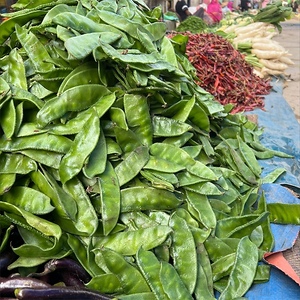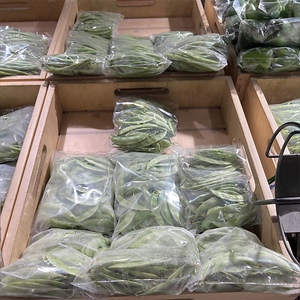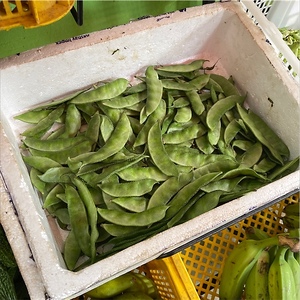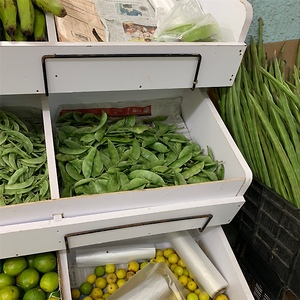

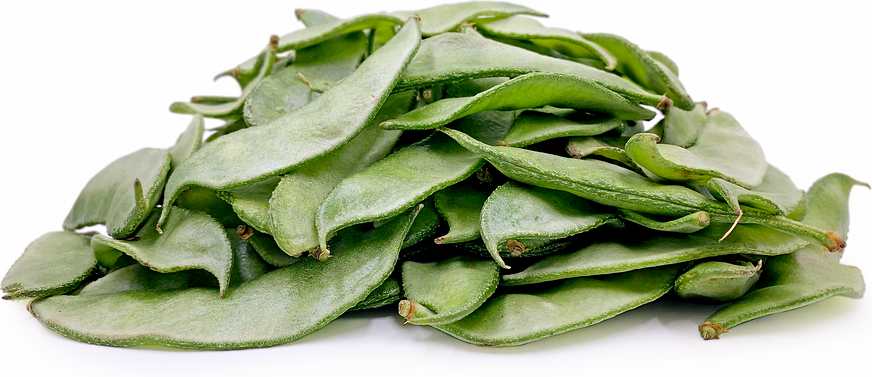
Indian Broad Beans
Estimated Inventory, lb : 0
Description/Taste
Indian Broad beans are long, flat, and slightly curved, growing up to twenty centimeters in length. The shell is green, smooth, and soft to the touch. Inside the pod, the fiber is moist and contains three to six oval-shaped seeds which can be tan, white-green, or green depending on the variety. Most Indian Broad beans have strings that should be removed, although some varieties have been developed to eradicate the strings. Indian Broad beans are aromatic, sweet, and tender when cooked.
Seasons/Availability
Indian Broad beans are available year-round.
Current Facts
Indian Broad beans, botanically classified as Dolichos lablab, are a type of hyacinth bean and are members of the Fabaceae family. Also known as Avarai, Avarakkai, Sem, Sheem, and Val Papdi in India and as Lablab beans, Flat beans, and Indian beans in English, Indian Broad beans grow on thick vines with broad leaves and thrive in tropical climates. Often confused with the purple-podded ornamental variety of hyacinth bean, Indian Broad beans are a green variety grown in backyard gardens for culinary purposes. Indian Broad beans are consumed when they are young, tender, and slightly flattened, before the inner seeds have fully grown and filled out the pod. While other hyacinth beans contain glycosides, which are toxic when raw and must be boiled thoroughly before use, the Indian Broad bean does not have to be pre-boiled.
Nutritional Value
Indian Broad beans contain calcium, copper, phosphorus, magnesium, zinc, and iron. They also contain some dietary fiber and vitamin C.
Applications
Indian broad beans are best suited for cooked applications such as boiling, steaming, and sautéing. They are commonly used in curries and stir-fries and can be cut into bite-sized pieces and used in recipes that call for snap peas or green beans. They can also be shelled and used in recipes that call for lima beans. In India, the beans are used to make dals and bhortas, which is a baba ghanoush-like mash made with mustard oil. They are also incorporated into soups, salads, desserts, and main courses that contain rice and vegetables. Indian broad beans pair well with onions, garlic, turmeric, cumin, curry leaves, chiles, mustard seeds, poppy seeds, ghee, and oil. Indian broad beans will keep up to a week when stored fresh in the refrigerator.
Ethnic/Cultural Info
Indian Broad beans are a treasured home garden vegetable in India, and it is said that the very scent of Indian Broad beans can evoke memories of home. Indian Broad beans are also used in many celebrations. In Maharashtra, Indian Broad beans are used during the fasting month of Shravan which is a season dedicated to the god Shiva. In Andhra Pradesh, Indian Broad beans are cooked in special dishes during the celebratory Pongal season which is dedicated to the sun god. Like other hyacinth beans, Indian Broad beans are also used to aid in digestion.
Geography/History
The exact origin of Indian Broad beans is relatively unknown. Hyacinth beans are believed to have come from Africa and then spread to India between 1600 and 1500 BCE. Indian Broad beans can be found at markets and specialty stores throughout India and in select cities throughout Asia, Europe, and the United States.
Recipe Ideas
Recipes that include Indian Broad Beans. One



